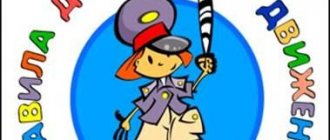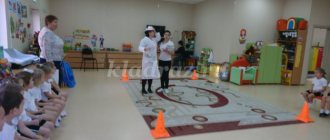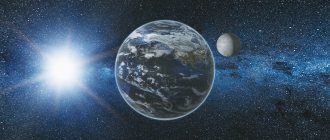Project "In the World of Dinosaurs"
Project "In the World of Dinosaurs"
Author of the development
Babynina Olsha Sergeevna,
teacher
Project title: “In the world of dinosaurs”
A problem that is significant to children and that the project aims to solve.
Who are dinosaurs and what did they eat? How dinosaurs took care of their children. Do animals similar to dinosaurs exist now? Why did dinosaurs become extinct?
Relevance of the project.
From birth, a child is a discoverer, an explorer of the world that surrounds him. Modern children, due to their excessive activity, cannot always find the answer to their questions on their own. Based on the interests of children, the teacher must create a fascinating world of learning that would help them develop independent research interest and a desire to engage in productive and creative activities.
The child is fascinated by everything that happens around him. Watching the children, I noticed that the children began to be interested in the ancient world and its disappeared inhabitants. When did dinosaurs live and why did they disappear - questions that children often ask. And they need to try to give the most truthful and understandable information to them. After all, there is still no clear answer about the reason for the extinction of dinosaurs. In addition, the relevance of the topic is that this is the past of our planet, and in order to look into the future, we need to know our past.
Target.
Formation of children's ideas about the era of dinosaurs.
Tasks.
1. Introduce the amazing animals of the past - dinosaurs, the variety of dinosaur species and their external features.
2. Form ideas about the study of these ancient animals by scientists;
3. Continue to develop cognitive processes: speech, memory, thinking, imagination, attention, coherent speech while working on the project
4. Continue to cultivate a sense of caring attitude towards living nature.
5. Involve parents in joint activities with children, create an atmosphere of common interests for the development and upbringing of children.
Project type.
According to the leading method
: informational and creative project, educational.
According to the nature of the child’s participation in the project
: participant from the inception of the idea to the receipt of the result
By the nature of contacts
: within the same age group, in contact with family
By number of participants:
group.
By duration
: short-term (two weeks).
Project participants
: teacher, children, parents.
Location
. MBDOU kindergarten "Belochka" Krasninsky district.
Materials
: scientific and fiction literature, encyclopedia, images of various types of dinosaurs, films and cartoons about the life of dinosaurs, gouache paints, brushes, colored pencils, album sheets, colored paper, glue, scissors, coloring books with images of dinosaurs, etc.
Expected results:
working on the project will help participants :
for children:
acquire knowledge about the era of dinosaurs ,
expand the understanding of
dinosaur
for teachers:
accumulate information and better understand the ideas and actions of preschool children in educational activities
parents:
actively participate in project activities ,
through joint cognitive and research activities.
Project stages
: preparatory, main, final.
Implementation plan for the preparatory stage of the project.
| № | Events or main activities | Participants | Responsible |
| 1. | Preparation of information material and drawing up a work plan | Educator Parents | Parents Educator |
Implementation plan for the main stage of the project
| № | Events or main activities | Participants | Responsible |
| 1 | Watching the cartoon "Ice Age" | Educator children | Educator |
| 2 | Conversation based on illustrations “ Who are dinosaurs and when did they live? » | Educator children | Educator |
| 3 | Modeling from plasticine “Dinosaur” | Educator children | Educator |
| 4 | Watching the film “Scientists have found evidence of the existence of dinosaurs” | Educator children | Educator |
| 5 | Working with coloring books and stencils “Dinosaurs” | Educator children | Educator |
| 6 | Board game - panorama "Dinosaurs", lotto game "Dinosaurs" | Educator children | Educator |
| 7 | Didactic and low mobility games with dinosaur figures | Educator children | Educator |
| 8 | Watching cartoons “Dinosaur”, “The Land Before Time”. | Educator children | Educator |
| 9 | Memo for parents “Tell your children about dinosaurs” | Educator parents | Educator |
| 10 | DrawingCreating dinosaurs from salt dough (Appendix 8Drawing “My Favorite Dinosaur” | Educators children | Educator |
| 11 | A selection of poems and stories about dinosaurs | Parents children | Educator |
Implementation plan for the final stage of the project
| № | Events or main activities | Participants | Responsible |
| 1 | Making a wall newspaper “Valley of Dinosaurs”. | Educators children | Educator |
Photo gallery
Sources of information used
My first encyclopedia. “Dinosaurs” - M.: Egmont Russia, 2001.
Travina I.V. My first book about dinosaurs. Popular science publication for children. - M.: JSC "ROSMEN-PRESS", 2007. - 95 p.
Dinosaurs. Smart stencils. – OSE, 2013.
Fisher E. Dinosaur Book of Records. – M.: Publishing house EKSMO-Press, 2002.
Khomich E.O. Tell me everything about dinosaurs. – M.: AST Publishing House, 2016.
16
Progress of the study
One day I saw a scientific film about dinosaurs on TV, and I became interested in the question: did dinosaurs exist on our planet?
I turned to my dad with this question.
Dad said that dinosaurs inhabited our planet millions of years ago, and today there is not a single living representative.
Then, of course, I decided to ask my mother, who are dinosaurs?
Mom said that dinosaurs are terrible lizards, but you shouldn’t be afraid of them, since they became extinct and no longer live on Earth.
But these answers raised even more questions in my head: why did dinosaurs become extinct, what did they eat, and which dinosaur was the largest? For answers to these questions, I again turned to my dad, he is already an adult and knows everything about dinosaurs.
Dad said that there were dinosaurs that were herbivores (who ate grass) and carnivores (which ate other dinosaurs, usually herbivores).
Since then, I began to get interested in collecting information about them. I watched films and cartoons about dinosaurs, collected collections of toy dinosaur figurines, coloring books and encyclopedias about them. I'm interested in how and where they lived, what they ate, what types of dinosaurs there were and why they became extinct.
Thus the idea was born to conduct research work on the life of these unfamiliar lizards.
MAGAZINE Preschooler.RF
Project for the preparatory group “Collection-dinosaurs”Project passport: Teachers: Nemirova Y.K., Guzhova I.V.
Project theme: collection of our group “Dinosaurs” .
Relevance of the project:
The modernization of preschool education has led to the search for new forms of organizing education in kindergarten, since the education of preschoolers has its own characteristics. The main result of modern education is not what the child has learned, but how much it has contributed to his development and the formation of integrative personality traits.
For the formation of cognitive activity of preschoolers, such an area as collecting is of interest.
Collecting is invaluable for the development of preschoolers. The task of adults is not only to captivate the child with the idea of creating a collection, but also to help him in every possible way in this. Since the benefits of this type of activity are undeniable and invaluable:
- Cognitive and research activity is one of the natural areas of activity clearly demonstrated by preschoolers. Children have a natural urge to collect, or more precisely, to search. In the process of collecting, the process of accumulating knowledge first occurs, then the information received is systematized and a readiness to understand the world around us is formed. Items from the collections add originality to gaming, speech and artistic creativity and activate existing ideas.
- In the process of collecting, attention, memory, thinking, the ability to observe, compare, analyze, generalize, highlight the main thing, and combine are developed. Collecting broadens children's horizons, develops their cognitive activity, and develops the child's abilities, which are steps to creativity.
- Many problems in establishing relationships with children can be overcome if you find a common cause that allows you to combine the interests of the child and the adult. This is relevant when there are children in the group with uneven behavior, motor-active, anxious, uncommunicative and shy.
- Collecting decorates our lives, makes it fuller and more varied.
In our group we created a collection of dinosaurs.
Paleontologists have long debated when dinosaurs lived and died out. This topic is especially interesting for our little people – children. When did dinosaurs live and why did they disappear - questions that children often ask. And they need to try to give the most truthful and understandable information to them. After all, there is still no clear answer about the reason for the extinction of dinosaurs.
One day Gleb brought a new toy to kindergarten. It was a big dinosaur. The guys were very interested in this unusual animal. Children asked a lot of questions about when dinosaurs lived, what they ate, and how they reproduced. In this connection, it became clear that the topic of prehistoric inhabitants of the planet is of interest to the children of our group. And we decided to find out everything about dinosaurs, the time when they lived, and, of course, the reasons for the extinction of dinosaurs. Suddenly, knowing these reasons, it is possible to prevent the extinction of other animals in the future. In addition, the relevance of the topic is that this is the past of our planet, and in order to look into the future, we need to know our past.
The goal of the project is to develop cognitive and research activities in preschool children through collecting.
Project objectives:
- introduce the amazing animals of the past - dinosaurs, the variety of dinosaur species and their external features;
- develop cognitive processes: speech, memory, thinking, imagination, attention, coherence;
- continue to develop cognitive skills: observation, ability to compare, classify, group and generalize, draw conclusions;
- cultivate a sense of caring attitude towards living nature;
- to involve parents in the implementation of joint child-adult activities, to create an atmosphere of community of interests for the development and upbringing of children.
The duration of the project is short-term, 2 weeks.
Place of implementation - MDOU "Kindergarten No. 113" .
The participants of the project are teachers, children, parents.
Implementation stages:
- preparatory:
- collection and processing of information;
- conversations - “Who are dinosaurs?” , “What did dinosaurs eat?” , “How did dinosaurs take care of their offspring?” , “Are there animals similar to dinosaurs?” , “How do we know about dinosaurs” ;
- watching cartoons “Ice Age” , “Dinosaur” , “The Land Before Time” ;
- exhibition and reading of a collection of books about dinosaurs;
- reading the encyclopedia “How life appeared on Earth” , “The World of Dinosaurs” ,
- selection of illustrations;
- dinosaur coloring pages;
- modeling dinosaurs from plasticine;
- selection of toy dinosaurs;
- viewing a presentation for children “Who are dinosaurs” .
- basic
- production of a three-dimensional model of “Dinopark” ;
- making your own hand-made book “The World of Dinosaurs” ;
- presentation of the “Dinosaurs” for children of other groups;
- musical entertainment "Onega Collections" .
- final
- a presentation of the layout was made for children of other groups and parents;
- the design of the man-made album “The World of Dinosaurs” ;
- A final discussion about dinosaurs was held.
Conclusion
The use of collecting technology in the educational process expands the teacher’s capabilities in organizing interesting and educational activities with children. The substantive basis of collecting coincides with the child’s cognitive interests.
In the process of collecting, children formed ideas about the objects of the surrounding world on the topic of collections; showed activity, initiative, developed creative abilities in various types of children's activities; parents became active in the educational process (in the creation and presentation of children’s collections); The level of parents' satisfaction with the organization of the educational process has increased.
| Next > |
My story about dinosaurs
I know that some dinosaurs were the size of a multi-story building.
They had wings, crests, feathers and spines, jaws and claws. But not all dinosaurs were giants .
Small but fast dinosaurs also lived on Earth . Dromaeosaurus was the size of a wolf. He had sharp claws on each paw. The dinosaur ate other dinosaurs , which were supposed to run even faster than him!
Also, dinosaurs needed powerful muscles to run, fight and hunt. Only the fastest and strongest survived
Looking at animals in our time, we can understand how the dinosaur organism worked . The structure of dinosaurs is in many ways similar to the structure of reptiles and birds. They are indeed distant relatives!
I have encyclopedia books about dinosaurs and their lives. And in one of them, I learned that some herbivorous dinosaurs swallowed stones . They helped animals digest food. Modern crocodiles and sea lions also swallow stones.
Some of the dinosaurs were carnivores, others were herbivores. Therefore, there was enough food for everyone. Dinosaurs were well adapted to life on land. They had very tough skin.
Some of them had huge, massive bodies and long necks - this helped them reach the treetops.
Some dinosaurs were slow and clumsy, while others were very playful and fast.
Carnivorous dinosaurs had large claws, strong jaws and sharp teeth. Some predators were hunting. Others stole their spoils.
My favorite dinosaur, the Tyrannosaurus Rex, also lives during this period. This is a huge predatory dinosaur . He walked on two hind legs,
the front legs were very short.
My mother and I went to the library, where I learned a lot of interesting things.
Baby tyrannosaurs were born covered in thick down, which helped them keep warm. With age he disappeared. The female tyrannosaurus was a caring mother. She could go without food for a long time when she was guarding the nest, and when the cubs were born, she did not abandon them, but fed and took care of the cubs for up to 6 months.
But no one knows what color dinosaurs were . Probably some were green and brown, the color of the forest. This makes it easier to hide from enemies. And others could be brightly colored, striped and spotted, like parrots, snakes and lizards.
Together with my mother, we made a model of the life of dinosaurs.
conclusions
After conducting research work, I learned a lot about the life of dinosaurs on our planet. Each species that inhabited the earth had its own characteristics of body structure; some dinosaurs led a herd lifestyle, while others, on the contrary, were solitary . Dinosaurs, like birds, laid eggs. Dinosaurs, it turns out, were responsible parents and took care of their young.
In my group, I told the kids about who dinosaurs were, what their types were, what they ate, what time they lived and why they died.
If you liked the page, share it on social networks:



